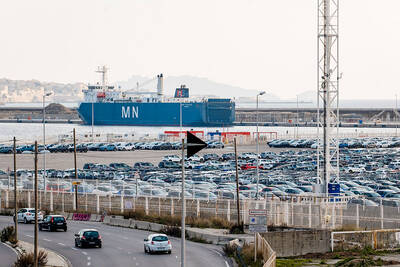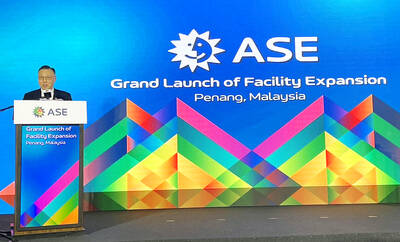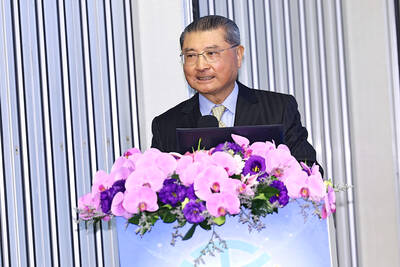Asia’s copper industry is to meet in Hong Kong starting on Tuesday to discuss a market that should be bursting with opportunities after China, the biggest consumer of the metal, called an end to the COVID-19 pandemic restrictions strangling its economy.
The government’s pledge to raise economic growth, and an increasingly outsized contribution to demand from its rapid build out of clean energy, have spurred optimism that China’s reopening would help offset weaker activity elsewhere in the world.
However, the reality on the ground is much gloomier as traders seek evidence of a uptick in consumption that has so far proved elusive in the months since Beijing lifted its “zero COVID” curbs.

Photo: Reuters
“Many people in the industry are disappointed by Chinese demand so far this year,” said Shen Haihua (沈海華), a portfolio manager at Hong Kong-based hedge fund Entropy Asset Management Ltd. “I think most specialists are on the short side.”
The London Metal Exchange’s (LME) gathering is its first in-person meeting in Asia since the pandemic struck, convening more than a thousand executives, traders, bankers and analysts to chew over the latest industry news, and wine and dine old friends in the territory’s bars and restaurants.
Less than two months ago, few were betting against copper’s prospects after the world’s top trader of the metal, Trafigura Group, told a conference in London that it expects prices to hit a record within a year.
What has changed is a slew of data indicating that China’s recovery is losing momentum. A survey of purchasing managers showed the factory sector contracting last month for the first time this year, while copper imports dropped to their lowest since October last year.
Chinese imports of the metal in the first four months are lagging 13 percent behind the pace set last year, when copper purchases boomed despite generally weaker demand for other commodities.
The metal is down about 8 percent on the LME so far this quarter. It on Friday fell 3.68 percent to US$8,163.50 per tonne.
In the US, copper for July delivery rose US$0.02 to US$3.73 per pound.
That speaks to one explanation for why consumption might have fallen short of expectations.
Chinese industry suffered less than other parts of the economy during COVID-19 slowdowns, said Capital Economics Ltd, a London-based research firm, which means that post-virus growth was only ever going to be modest.
At the same time, China’s need for metals like copper is being capped by softer demand for exports as other nations flirt with recession.
Copper prices have long been considered a useful barometer of an economy’s health because of its widespread usage, from power cables, to pots and pans and mobile phones. As such, its fortunes have been closely tied to China’s rapid growth in the past few decades, and a proxy to test the global demand.
Copper’s recent slump is telling us the global economy is in real trouble, Societe Generale SA strategist Albert Edwards wrote on Twitter.
So it is instructive that Chinese traders surveyed by Bloomberg ahead of the LME event are tilting toward prices falling in the short term.
Some said they are experiencing the worst margins in over 10 years, while smelters are turning to exports to compensate for a sluggish domestic market.
Copper is too scarce and too valuable to the energy transition to be on the ropes for long, but timing its resurgence is becoming increasingly fraught given the frailty of the world economy and the absence of robust Chinese demand.
From January to last month, copper in China has averaged about 400 yuan (US$57.90) per tonne less than London prices. The premium at the port of Yangshan, which measures import needs, has more than halved since mid-March and is bumping along near record lows, and that is during a second quarter which is usually considered to be a peak period of consumption among fabricators of the metal.
On the LME itself, the world’s premier exchange for metals, volatility — the lifeblood of the market — has slumped. On a 30-day basis, price fluctuations have fallen to their lowest since November 2020, forcing traders to the sidelines.
Lackluster consumption is the biggest problem, but another factor is that China’s smelting industry is still expanding. That means more demand for ores and concentrates mined overseas, and less for the refined metal that backstops futures markets such as the LME.
Copper’s value as an asset has also waned after the collapse of China’s biggest trader sent a chill through dealing rooms and subdued the appetite among lenders for using the metal as collateral on loans.
Other commodities:
‧ Gold for June delivery fell US$0.70 to US$2,019.80 per ounce, down 0.25 percent from a week earlier.
‧ Silver for July delivery fell US$0.27 to US$24.15 per ounce, down 6.86 percent from the previous week.
Additional reporting by AP

When an apartment comes up for rent in Germany’s big cities, hundreds of prospective tenants often queue down the street to view it, but the acute shortage of affordable housing is getting scant attention ahead of today’s snap general election. “Housing is one of the main problems for people, but nobody talks about it, nobody takes it seriously,” said Andreas Ibel, president of Build Europe, an association representing housing developers. Migration and the sluggish economy top the list of voters’ concerns, but analysts say housing policy fails to break through as returns on investment take time to register, making the

‘SILVER LINING’: Although the news caused TSMC to fall on the local market, an analyst said that as tariffs are not set to go into effect until April, there is still time for negotiations US President Donald Trump on Tuesday said that he would likely impose tariffs on semiconductor, automobile and pharmaceutical imports of about 25 percent, with an announcement coming as soon as April 2 in a move that would represent a dramatic widening of the US leader’s trade war. “I probably will tell you that on April 2, but it’ll be in the neighborhood of 25 percent,” Trump told reporters at his Mar-a-Lago club when asked about his plan for auto tariffs. Asked about similar levies on pharmaceutical drugs and semiconductors, the president said that “it’ll be 25 percent and higher, and it’ll

CHIP BOOM: Revenue for the semiconductor industry is set to reach US$1 trillion by 2032, opening up opportunities for the chip pacakging and testing company, it said ASE Technology Holding Co (日月光投控), the world’s largest provider of outsourced semiconductor assembly and test (OSAT) services, yesterday launched a new advanced manufacturing facility in Penang, Malaysia, aiming to meet growing demand for emerging technologies such as generative artificial intelligence (AI) applications. The US$300 million facility is a critical step in expanding ASE’s global footprint, offering an alternative for customers from the US, Europe, Japan, South Korea and China to assemble and test chips outside of Taiwan amid efforts to diversify supply chains. The plant, the company’s fifth in Malaysia, is part of a strategic expansion plan that would more than triple

Taiwanese artificial intelligence (AI) server makers are expected to make major investments in Texas in May after US President Donald Trump’s first 100 days in office and amid his rising tariff threats, Taiwan Electrical and Electronic Manufacturers’ Association (TEEMA, 台灣電子電機公會) chairman Richard Lee (李詩欽) said yesterday. The association led a delegation of seven AI server manufacturers to Washington, as well as the US states of California, Texas and New Mexico, to discuss land and tax issues, as Taiwanese firms speed up their production plans in the US with many of them seeing Texas as their top option for investment, Lee said. The